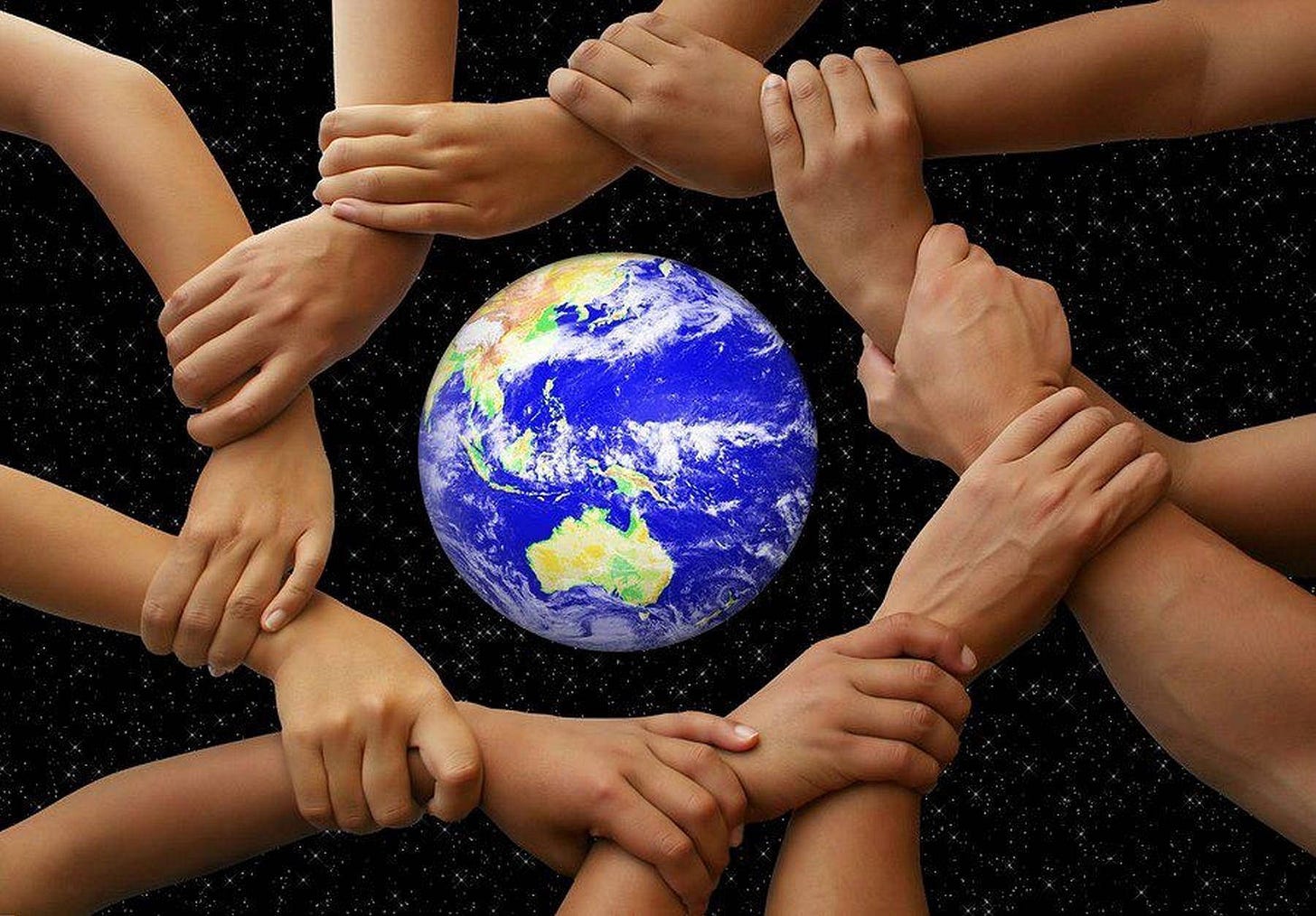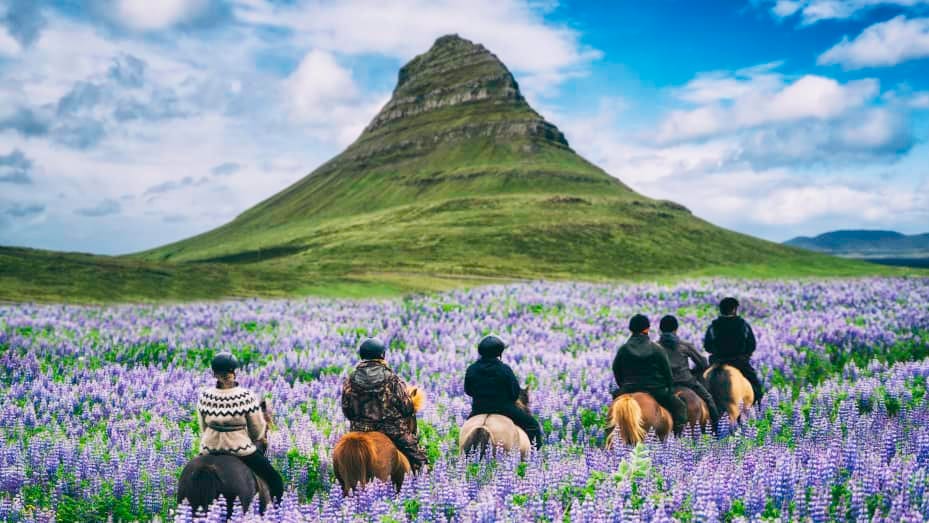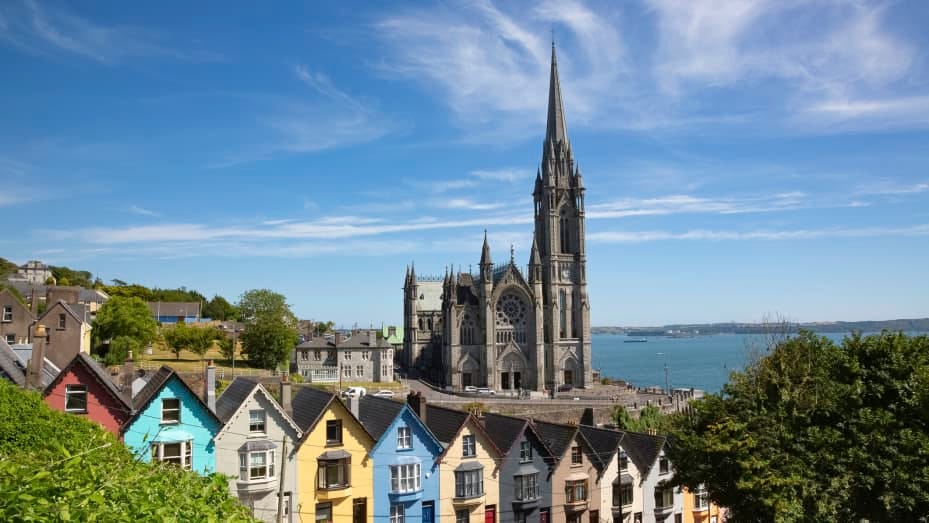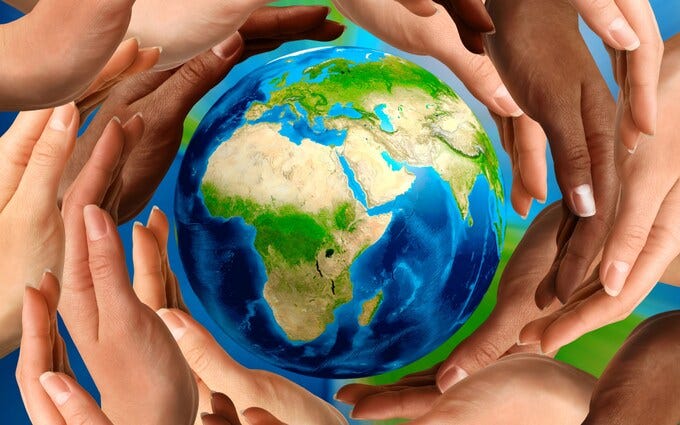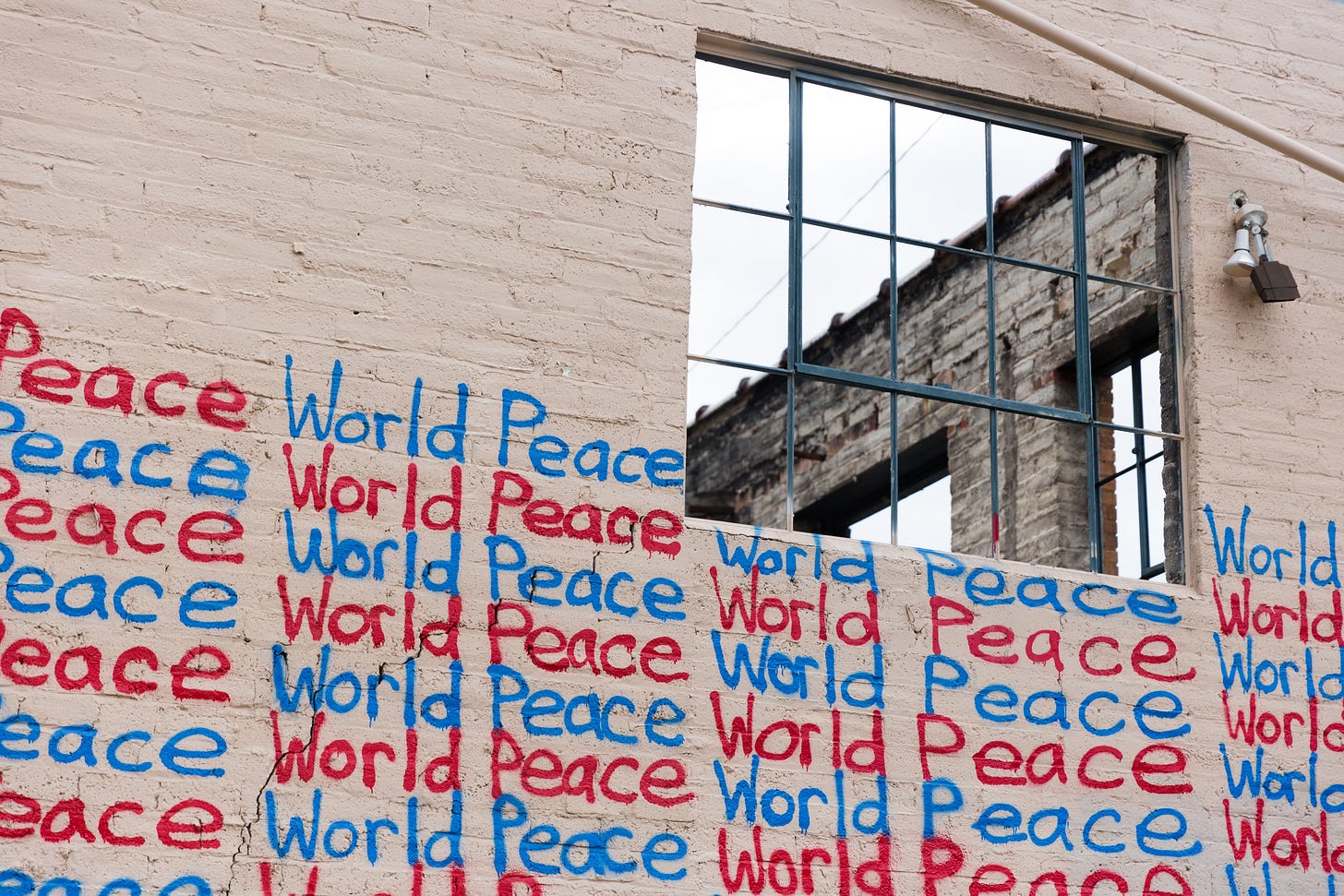"New Agenda for Peace": UN Plans to Save World from War 🌟🌎
World Peace Index 2023, from the most to the least peaceful countries ♡❥❣
The Peace of Wild Things
Wendell Berry
When despair for the world grows in me
and I wake in the night at the least sound
in fear of what my life and my children’s lives may be,
I go and lie down where the wood drake
rests in his beauty on the water, and the great heron feeds.
I come into the peace of wild things
who do not tax their lives with forethought
of grief. I come into the presence of still water.
And I feel above me the day-blind stars
waiting with their light. For a time
I rest in the grace of the world, and am free.
A New Agenda for Peace
António Guterres
Secretary-General of the United Nations
The post-Cold War period is over and we are moving towards a new era already marked by major competition for power and the highest level of geopolitical tensions in decades.
At the same time, the world faces new and developing threats that require urgent, united action:
Conflicts have become more complex, deadly, and harder to resolve.
Concerns about the possibility of nuclear war have re-emerged.
New potential domains of conflict and weapons of war are creating new ways in which humanity can annihilate itself.
Human rights are under attack across the world, including a pernicious pushback against women’s rights.
The UN Charter and international law; regional security architectures; nuclear disarmament and de-escalation – all tenets of multilateralism and the collective security system – have been questioned.
Frameworks for global cooperation have not kept pace with this new global landscape.
My New Agenda for Peace outlines a vision of multilateral efforts for peace and security, based on international law and framed around the principles of trust, solidarity, and universality.
The New Agenda for Peace presents concrete proposals in five priority areas:
1. Bolstering prevention at the global level, by addressing strategic risks and geopolitical divisions.
The New Agenda for Peace calls on countries to urgently recommit to pursuing a world free of nuclear weapons, and to reinforce the global norms against their use and proliferation.
We also need to step up preventive diplomacy at the global level in the face of growing fragmentation, and the potential emergence of geopolitical blocs with different trade rules, supply chains, currencies and internets.
2. Setting out a vision for preventing conflict and violence, and sustaining peace, that applies to everyone, in all countries, at all times.
This calls for a paradigm for prevention that addresses all forms of violence; focuses on mediation; promotes social cohesion; prioritizes the links between sustainable development, climate action, and peace; and is anchored in full respect for all human rights – civil, political, economic, social and cultural.
3. Updating the UN’s approach to peace operations, recognizing the realities of today’s conflicts.
Peacekeeping missions must have adequate resources and the full political support of the Security Council, with active, continuous engagement with all parties.
The New Agenda for Peace calls for a serious, broad-based reflection on the future of UN Peacekeeping Operations, with a view to moving towards nimble, adaptable models with appropriate exit strategies in place.
4. Preventing the weaponization of emerging domains and technologies, and promote responsible innovation.
Infrastructure essential for public services and to the functioning of society must be declared off-limits to malicious cyber activity.
My proposal also calls on countries to adopt a legally binding instrument to prohibit lethal autonomous weapons systems that function without human control.
It also highlights the need for new national strategies to mitigate the peace and security implications of artificial intelligence, and calls for a multilateral process to develop norms, rules and principles around military applications of AI.
5. Updating our collective security machinery to restore its legitimacy and effectiveness.
The world needs collective security structures that represent the geopolitical realities of today, and the contributions made by different regions to global peace.
The New Agenda for Peace recommends urgent reforms to the Security Council to make it more just and representative, and the democratization of its procedures.
It also proposes revitalizing the work of the General Assembly and reforming the disarmament machinery, and proposes enhancing the role of the Peacebuilding Commission.
Peace is the driving force behind the work of the United Nations. Today’s new threats to peace create new demands on us.
The time to act is not when the divisions and fractures have engulfed us.
The time to act is now.
https://www.un.org/sites/un2.un.org/files/our-common-agenda-policy-brief-new-agenda-for-peace-en.pdf
A New Agenda for Peace
Highlights:
Member States must provide a response to the deep sense of unease which has grown among nations and people that Governments and international organizations are failing to deliver for them. For millions of people, the sources of that disappointment are to be found in the horrors of hunger, displacement and violence. Inequalities and injustices, within and among nations, are giving rise to new grievances. They have sown distrust in the potential of multilateral solutions to improve lives and have amplified calls for new forms of isolationism. As the planet warms, marginalization grows and conflicts rage, young people everywhere have grown disillusioned at the prospects for their future.
This new multilateralism must recognize that the world order is shifting. It must adjust to a more fragmented geopolitical landscape. It must respond to the emergence of new potential conflict domains. It must also rise to address myriad global threats that have locked States into interdependence, whether they desire so or not. This new multilateralism demands that we look beyond our narrow security interests. The peace that we envisage can be pursued only alongside sustainable development and human rights.
Nonetheless, peace remains an elusive promise for many around the world. Conflicts continue to wreak destruction, while their causes have become more complex and difficult to resolve. This may make the pursuit of peace appear a hopeless undertaking. However, in reality, it is the political decisions and actions of human beings that can either sustain or crush hopes for peace. War is always a choice: to resort to arms instead of dialogue, coercion instead of negotiation, imposition instead of persuasion. Therein lies our greatest prospect, for if war is a choice, peace can be too. It is time for a recommitment to peace. In the present document, I offer my vision of how we can make that choice.
We must, however, be clear-eyed about the magnitude of the problems before us. What is at stake is not the future of the United Nations, but of our nations and humanity. The possibility of global devastation, whether from nuclear weapons, climate change, diseases or war, or even technology run amok, is tangible and increasing. Member States will need to find new ways of working together despite the increasing mistrust that has permeated international relations.
Iceland is the No. 1 most peaceful country in the world
Iceland remains the most peaceful country in the world, according to the 2023 Global Peace Index.
The 2023 Global Peace Index released its annual ranking of the most peaceful countries in the world.
The Institute for Economics and Peace 2023 study measured a country’s level of negative peace using three domains of peacefulness:
Ongoing domestic and international conflict
Societal safety and security
Militarization
Overall the index found that the world is a little less safe than last year, due to the impacts of the COVID-19 pandemic — which is unchanged from the 2022 survey results.
While the United States ranked 131 on the list, seven out of the top 10 most peaceful countries in the world are in Europe.
Denmark is the second most peaceful country in the world.
No. 1 most peaceful country in the world: Iceland
Iceland has remained the most peaceful country in the world since the study was first released in 2008.
It also ranks as the third happiest country in the world, after Finland and Denmark.
More than 60% of the country’s population lives in the capital city of Reykjavik, according to National Geographic,
In Iceland, school is free for all Icelanders through college, and every student is taught to speak Danish and English.
Top 10 most peaceful countries in the world
Iceland
Denmark
Ireland
New Zealand
Austria
Singapore
Portugal
Slovenia
Japan
Switzerland
The second country on the list is Denmark.
Denmark’s capital, Copenhagen, is home to institutions such as the Copenhagen Stock Exchange and serves as a hub connecting Northern Europe with the rest of the world, according to U.S. News and World Report.
Although people living in Denmark pay some of the world’s highest taxes, up to half of their income, it is for a reason.
Due to the high taxes, Denmark can offer its citizens most healthcare options with no fee, university students pay no tuition and receive a grant to help cover expenses while studying, childcare is subsidized, and the elderly receive pensions and are provided with care helpers who visit them at home, according to the country’s website.
Ireland rounds out the top 3 most peaceful countries in the world.
After Great Britain, Ireland is Europe’s second largest island. Ireland is known for its lush, green fields hence its nickname, Emerald Isle, according to National Geographic.
Ireland’s population has increased by 10 percent in the last decade, according to a report released by the Central Statistics Office. According to the report’s author, the country’s population growth is among the fastest in the European Union.
Global Peace Index 2023
Conflict deaths at highest level this century causing world peacefulness to decline
London, June 28, 2023, Today marks the launch of the 17 th edition of the Global Peace Index from international think-tank, the Institute for Economics & Peace (IEP).
Key results
Deaths from global conflict increased by 96% to 238,000
New data shows higher number of conflict deaths in Ethiopia than Ukraine, eclipsing the previous global peak during the Syrian war
79 countries witnessed increased levels of conflict including Ethiopia, Myanmar, Ukraine, Israel, and South Africa
The global economic impact of violence increased by 17% or $1 trillion, to $17.5 trillion in 2022, equivalent to 13% of global GDP
A Chinese blockade of Taiwan would cause a drop in global economic output of $2.7 trillion, almost double the loss that occurred due to the 2008 global financial crisis
Despite the conflict in Ukraine, 92 countries improved on military expenditure and 110 decreased their military personnel
Conflicts are becoming more internationalised with 91 countries now involved in some form of external conflict, up from 58 in 2008
Impact of the War in Ukraine on Peacefulness
Ukraine recorded the largest deterioration, falling 14 places to 157th
The economic impact of violence has increased by 479% or $449 billion, equivalent to 64% of Ukraine’s GDP
Despite the conflict, Russia’s incarceration rate, violent demonstrations, terrorism impact and homicide rates have improved over the past year, with the homicide rate at its lowest since 2008
65% of men in Ukraine aged 20 to 24 years have fled the country, or died in the conflict
Global Peace Index World Map: From the most to the least peaceful nations:
https://www.visionofhumanity.org/maps/#/
The 17th edition of the annual Global Peace Index (GPI), the world’s leading measure of peacefulness, reveals the average level of global peacefulness deteriorated for the ninth consecutive year, with 84 countries recording an improvement and 79 a deterioration. This demonstrates that the deteriorations were larger than the improvements, as the post-COVID rises of civil unrest and political instability remain high while regional and global conflicts accelerate.
Iceland remains the most peaceful country, a position it has held since 2008, followed by Denmark, Ireland, New Zealand and Austria. For the sixth consecutive year, Afghanistan is the least peaceful country, followed by Yemen, Syria, South Sudan, and the Democratic Republic of Congo. Highlighting the shifting dynamics of conflict, both Afghanistan and Syria recorded improvements in peacefulness.
Ukraine's overall score recorded a decline of 13%, the largest deterioration in the 2023 GPI, and is now 157th on the Index. Libya experienced the largest improvement in overall peacefulness, improving by 7% and rising 14 places to 137th.
The shift in the global distribution of conflict continued as major conflicts in the MENA region and South Asia declined, while conflicts in sub-Saharan Africa, Europe, and Asia-Pacific intensified. The Russia and Eurasia region recorded the largest deterioration in peacefulness in the world.
Militarization and Technology
Although conflict is increasing, more countries are directing military expenditure toward other priorities including healthcare, education, infrastructure, and pandemic recovery. The improvements in militarization were widespread with every region improving. However, the total military spending increased by 17% since 2008 with the largest increases coming from China ($180 billion), the US ($70 billion), and India ($40 billion).
Drones are being increasingly used in conflicts, including in Ukraine, Ethiopia, and Myanmar. The total number of drone attacks increased by 41% in 2022, with the number of different groups using drones increasing by 24%.
Download/open Global Peace Index 2023:
About the Global Peace Index (GPI)
Produced by the international think-tank the Institute for Economics & Peace (IEP), the GPI report presents the most comprehensive data-driven analysis to date on peace, its economic value, trends, and how to develop peaceful societies. The report covers 99.7% of the world's population and uses 23 qualitative and quantitative indicators from highly respected sources to compile the Index. These indicators are grouped into three key domains: Ongoing Conflict, Safety and Security, and Militarisation.
About the Institute for Economics and Peace (IEP)
IEP is an international and independent think tank dedicated to shifting the world's focus to peace as a positive, achievable and tangible measure of human well-being and progress. It has offices in Sydney, Brussels, New York, The Hague, Mexico City and Harare.
https://www.visionofhumanity.org/wp-content/uploads/2023/06/GPI-2023-Web.pdf
Italian Fascism: A Seminar
As promised, here is a syllabus on Italian Fascism. It’s a very revised version of what I have used at past institutions. Some academic publications are prohibitively expensive if you don't have access to a digital copy in a library, but I've kept them on the list anyway in case you have a way in.
What does it mean to teach a course on Fascism today? Do you stick strictly to history, or point out parallel developments in our own times? Do you only speak about other Fascisms (Nazism, early Franco) or do you talk about common features all dictatorships have whether they are Communist or Fascist? Personality cults are an obvious example: the "rules" that govern them are amazingly similar across time, space, and political leanings.
I teach mostly about this particular Fascism --which is the class the students signed up for, after all--and then draw parallels with other authoritarian experiences where relevant.
______________________
ITALIAN FASCISM
Course Description
Fascism is back in the news today, with right-wing movements finding popularity in Europe and strongmen rulers finding favor. This interdisciplinary course gives us background to understand our contemporary world by examining Benito Mussolini’s dictatorship. We address Fascism’s culture of violence; biopolitics and demographic policy; imperialism and war; Fascist ideology and visual culture; gender roles; and anti-Fascism.
What is Fascism and How Can We Study It?
Ruth Ben-Ghiat, “Fascism: History of a Term” excerpted as "What is Fascism?"
Jason Stanley, How Fascism Works, excerpts
Robert Paxton, The Anatomy of Fascism, 3-23
Umberto Eco, Ur-Fascism
The Rock Cries Out to Us Today
A Rock, A River, A Tree
Hosts to species long since departed,
Mark the mastodon.
The dinosaur, who left dry tokens
Of their sojourn here
On our planet floor,
Any broad alarm of their of their hastening doom
Is lost in the gloom of dust and ages.
But today, the Rock cries out to us, clearly, forcefully,
Come, you may stand upon my
Back and face your distant destiny,
But seek no haven in my shadow.
I will give you no hiding place down here.
You, created only a little lower than
The angels, have crouched too long in
The bruising darkness,
Have lain too long
Face down in ignorance.
Your mouths spelling words
Armed for slaughter.
The rock cries out today, you may stand on me,
But do not hide your face.
Across the wall of the world,
A river sings a beautiful song,
Come rest here by my side.
Each of you a bordered country,
Delicate and strangely made proud,
Yet thrusting perpetually under siege.
Your armed struggles for profit
Have left collars of waste upon
My shore, currents of debris upon my breast.
Yet, today I call you to my riverside,
If you will study war no more.
Come, clad in peace and I will sing the songs
The Creator gave to me when I
And the tree and stone were one.
Before cynicism was a bloody sear across your brow
And when you yet knew you still knew nothing.
The river sings and sings on.
There is a true yearning to respond to
The singing river and the wise rock.
So say the Asian, the Hispanic, the Jew,
The African and Native American, the Sioux,
The Catholic, the Muslim, the French, the Greek,
The Irish, the Rabbi, the Priest, the Sheikh,
The Gay, the Straight, the Preacher,
The privileged, the homeless, the teacher.
They hear. They all hear
The speaking of the tree.
Today, the first and last of every tree
Speaks to humankind. Come to me, here beside the river.
Plant yourself beside me, here beside the river.
Each of you, descendant of some passed on
Traveller, has been paid for.
You, who gave me my first name,
You Pawnee, Apache and Seneca,
You Cherokee Nation, who rested with me,
Then forced on bloody feet,
Left me to the employment of other seekers-
Desperate for gain, starving for gold.
You, the Turk, the Swede, the German, the Scot...
You the Ashanti, the Yoruba, the Kru,
Bought, sold, stolen, arriving on a nightmare
Praying for a dream.
Here, root yourselves beside me.
I am the tree planted by the river,
Which will not be moved.
I, the rock, I the river, I the tree
I am yours- your passages have been paid.
Lift up your faces, you have a piercing need
For this bright morning dawning for you.
History, despite its wrenching pain,
Cannot be unlived, and if faced with courage,
Need not be lived again.
Lift up your eyes upon
The day breaking for you.
Give birth again
To the dream.
Women, children, men,
Take it into the palms of your hands.
Mold it into the shape of your most
Private need. Sculpt it into
The image of your most public self.
Lift up your hearts.
Each new hour holds new chances
For new beginnings.
Do not be wedded forever
To fear, yoked eternally
To brutishness.
The horizon leans forward,
Offering you space to place new steps of change.
Here, on the pulse of this fine day
You may have the courage
To look up and out upon me,
The rock, the river, the tree, your country.
No less to Midas than the mendicant.
No less to you now than the mastodon then.
Here on the pulse of this new day
You may have the grace to look up and out
And into your sister's eyes,
Into your brother's face, your country
And say simply
Very simply
With hope
Good morning.
❤ ♥ ❥ ⛈
If you enjoyed this newsletter, please pass it along & recommend joining. Subscribe & support to keep vital connections & information going forward into a progressive future. ♞❣♘







